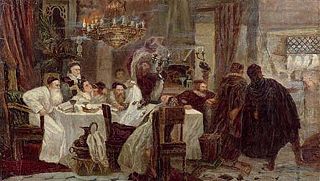 W
WThe history of the Jews in Bolivia stretches from the colonial period of Bolivia in the 16th century to the end of the 19th century. In the 19th century, Jewish merchants came to Bolivia, most of them taking local women as wives and founding families that merged into the mainstream Catholic society. This was often the case in the eastern regions of Santa Cruz, Tarija, Beni and Pando, where these merchants came either from Brazil or Argentina.
 W
WA converso, "convert", was a Jew who converted to Catholicism in Spain or Portugal, particularly during the 14th and 15th centuries, or one of his or her descendants.
 W
WCrypto-Judaism is the secret adherence to Judaism while publicly professing to be of another faith; practitioners are referred to as "crypto-Jews".
 W
WThe history of the Jews in Ecuador dates back to the 16th and 17th centuries, when Sephardic Jews began arriving from Spain and Portugal as a result of the Spanish Inquisition. Ecuadorian Jews are members of a small Jewish community in the territory of today's Ecuador, and they form one of the smallest Jewish communities in South America.
 W
WMarranos were Spanish and Portuguese Jews living in the Iberian Peninsula who converted or were forced to convert to Christianity during the Middle Ages, yet continued to practice Judaism in secret.
 W
WThe history of the Jews in Paraguay begins with the arrival of migration flows, mainly from Europe. The first waves of Jewish immigration to Paraguay began in 1904.
 W
WThe history of the Jews in Suriname starts at least in the 17th century, when in 1639, the English government allowed Spanish and Portuguese Jews from the Netherlands, Portugal and Italy to settle the region, coming to the old capital Torarica. In 1652, a new group that migrated under the leadership of Francis Willoughby, 5th Baron Willoughby of Parham came to Suriname and settled in the Jodensavanne area. A third group came 1664, after their expulsion from Recife and then French Guiana, led by David Cohen Nassy. According to the Encyclopedia of Latin America, "Suriname was one of the most important centers of the Jewish population in the Western Hemisphere, and Jews there were planters and slaveholders."